lower parts kit for AR Daniel Defense
Item number : DDZ021-1
| SKU | Designation | French Law | MSRP | Stock |
|---|---|---|---|---|
| SKU DDZ021-1 | Designation lower parts kit for AR DD | French Law B |
MSRP
220.00 € incl. tax
|
Out of stock
|
Build your own AR15.
AR15 lower receiver spare parts kit. The parts in this kit meet Mil-Spec standards.
List of kit parts:
- Semi-auto disconnector: When you pull the trigger, the hammer is released. When the round is fired and the slide moves back, pushing the hammer rearward, the disconnector holds the hammer until you release the trigger forward and re-engage the hammer. The disconnector prevents the dog from following the kingpin as it moves forward.
- Disconnector spring: Disconnector spring.
- Hammer Spring: Hammer spring
- Hammer with J-Pin semi-auto: Hammer with J-spring for a smooth and even pull to achieve rapid re-cocking.
- Spring Pin Slotted Bolt Catch: The Bolt Catch Roll Pin is a slotted steel spring pin. It is used to secure the bolt on Mil-Spec AR-15 lower receivers.
- Bolt Catch: Breech catch to block the bolt when the magazine is empty.
- Bolt Catch Plunger: The AR-15 bolt plunger is a component of the bolt assembly, which also includes the bolt, bolt bearing pin, and bolt spring. Located just outboard of the small recessed hole on the left side of the lower receiver that houses the bolt spring, sandwiched between the bolt and bolt spring, the bolt plunger is a small but vital component that serves as a intermediate between the lock and the lock spring. It is essentially secured by the fact that it is "stuck" between the two aforementioned components.
- Bolt Catch Spring: The bolt catch spring on an AR-15 rifle is a small coiled spring that places tension on the bolt catch mechanism. This spring helps hold the bolt carrier group (BCG) in place or lock it when the rifle is empty. When the magazine is empty, the follower inside the magazine pushes the bolt upward, engaging it in the bolt carrier, and the bolt spring helps hold it in that position until the shooter releases the slide by pressing the bolt release button. This is a crucial element for the proper functioning of the AR-15, ensuring that the slide functions properly during shooting and reloading.
- Magazine Catch: The magazine catch, also known as the magazine catch or magazine release, is a component of the AR-15 rifle that allows insertion and removal of the magazine. It is usually located on the right side of the lower part of the receiver, near the trigger guard.
The magazine catch consists of a button or lever that, when pressed or manipulated, releases the rifle's magazine. When the shooter presses the magazine catch, it disengages a mechanism that holds the magazine in place, allowing it to exit the magazine well.
This is an essential part of rifle operation because it facilitates quick and efficient magazine changes, allowing the shooter to quickly reload during shooting sessions. The design of the magazine catch may vary from one AR-15 model to another, but its fundamental role remains the same.
- Buffer Retaining Pin: The buffer retaining pin, also known as the buffer retainer, is a small, essential part of the AR-15 rifle lower receiver assembly. This pin is located on the rear of the gearbox, above the pistol grip.
Its main function is to retain the buffer and buffer spring in the gearbox extension (buffer tube). The pad retaining pin protrudes into the gearbox extension and holds the pad and spring under tension.
In normal operation, the buffer retaining pin holds the buffer and spring in place while allowing them to move back and forth in the buffer tube as the rifle cycles. When disassembling the AR-15, the buffer retaining pin must be depressed to remove the buffer and spring from the receiver extension, allowing maintenance and cleaning of these components.
Although small, the buffer retaining pin plays a crucial role in the proper operation and assembly of the AR-15 rifle lower.
- Buffer Retaining Pin: The buffer retaining spring, also called a buffer retaining spring, is a small coiled spring that works in conjunction with the buffer retaining pin in an AR-15 rifle. This spring puts tension on the buffer retaining pin and holds it in place in the bottom of the rifle.
Its primary function is to ensure that the buffer retaining pin remains engaged and properly retains the buffer and buffer spring in the receiver extension (buffer tube). This configuration allows the buffer and buffer spring to function properly during the rifle's cycle.
The buffer retainer spring is a critical component of the AR-15 lower body assembly, contributing to the overall functionality and reliability of the firearm.
-
Trigger Spring: The trigger spring on an AR-15 rifle is a component in the lower portion of the receiver that plays a crucial role in the operation of the trigger mechanism. This is a small coiled spring that puts tension on the different parts of the trigger.
Specifically, the trigger spring helps maintain proper tension on the trigger, disconnect, and hammer. When the shooter pulls the trigger, the trigger spring helps provide the resistance necessary for the trigger to move smoothly. When the trigger is squeezed, the spring compresses and helps reset the trigger after the shot.
The trigger spring is one of several components in the AR-15's complex trigger group, and its function is essential to the proper function and reliability of the firearm. Different trigger springs can be used depending on the specific trigger assembly or modifications to the rifle for custom performance.
- Semi Auto Trigger: The semi-automatic trigger on an AR-15 rifle refers to the trigger mechanism that allows the firearm to fire a round per pull of the trigger. In a semi-automatic rifle, each time the trigger is pulled, a single bullet is fired, and the firearm automatically reloads the next bullet into the chamber.
The trigger itself is part of the trigger group located in the lower portion of the AR-15. When the shooter pulls the trigger, it engages a series of mechanisms inside the firearm, releasing the hammer which strikes the firing pin, igniting the primer and firing the bullet.
- Ambi Selector Kit, SOPMOD: The selector is an essential element located on the lower part of the AR-15 rifle, generally above the pistol grip. It allows the shooter to choose between different firing modes, usually safe mode, semi-automatic mode, and sometimes burst mode or automatic mode (although civilian versions of the AR-15 generally do not feature the automatic option due to legal restrictions).
The selector has distinct positions:
Safe: The safety selector prevents the trigger from engaging, thereby blocking the firing mechanism of the firearm.
Semi-automatic: This position allows the firearm to fire one cartridge per pull of the trigger.
Burst or Full-Auto (if available): In military or selective-fire versions, this position allows multiple shots to be fired per pull of the trigger, either in bursts or continuously, depending on the configuration of the rifle.
Selector kit may refer to an assembly that includes the selector, triggers, springs, and other components necessary to install or replace the selector mechanism on the AR-15. It is an essential part of rifle operation, allowing the shooter to control the firing mode and improve safety by preventing accidental discharges.
- Takedown Pin: The takedown pin on an AR-15 rifle is a removable pin that plays an essential role in disassembly and assembly of the firearm. The AR-15 typically has two takedown pins: the front takedown pin and the rear takedown pin.
These pins hold the top and bottom of the gearbox together. When the pins are removed, the upper and lower receivers can be separated, allowing for maintenance, cleaning and customization of the rifle. Disassembly pins are usually captive, meaning they remain attached to the carcass and do not completely fall out when disassembled.
The front takedown pin is located on the front of the rifle, just above the front of the trigger guard, while the rear takedown pin is located on the rear of the rifle, above the pistol grip . Removing these pins is an essential step in disassembling the AR-15 for maintenance or modification.
- Detent, Takedown Pivot Pin: The pivot pin is a specific type of pin used in the assembly of an AR-15 rifle. This is one of the takedown pins, specifically the front takedown pin or pivot pin, that holds the upper and lower receivers of the firearm together.
This pin has a unique design that includes a small detent mechanism. The detent is a small spring-loaded plunger that interfaces with a corresponding hole in the receiver to secure the pin in place when inserted. When the pin is pushed into position, the detent engages, ensuring the pin stays securely in place and preventing it from slipping unintentionally during use.
The detent takedown pivot pin is a critical part of the AR-15 takedown mechanism, providing a secure connection between the upper receiver and lower receiver while allowing for quick and easy disassembly when required. necessary for maintenance or customization.
- Detent Spring Takedown Pivot Pin:
The takedown pivot pin trigger spring is a crucial component in the assembly of an AR-15 rifle. It is part of the mechanism that holds the front pivot or takedown pin in place, which holds the upper and lower receivers of the firearm together.
This spring is small and coiled, and it provides tension to the detent, which is a small spring-loaded piston. The detent, when pressed, fits into a hole or notch corresponding to the pivot pin, ensuring that it remains in place during assembly and use of the weapon fire. The detent spring tension is what keeps the detent engaged and prevents the takedown pivot pin from inadvertently coming loose or falling out.
Together, the trigger spring and the trigger itself function as a retention system for the pivot pin, allowing secure attachment of the upper and lower receivers while facilitating quick disassembly of the rifle when necessary for maintenance or customization.
- Trigger/Hammer Pin: The trigger and hammer pins on an AR-15 rifle are cylindrical metal pins that secure the trigger and hammer components to the lower portion of the firearm's frame.
These pins are essential to the operation of the trigger group. The trigger pin holds the trigger in place, allowing it to rotate smoothly when pulled. The hammer pin secures the hammer, which strikes the firing pin to ignite the cartridge primer and fire the cartridge.
The trigger and hammer pins are usually retained by small retaining rings or clips. They are positioned horizontally in the lower part of the receiver and are essential to maintain the correct alignment and operation of the trigger and hammer mechanisms. These pins must be properly installed and secured for the entire trigger to operate safely and reliably.
- Spring Magazine Catch/Release: Spring for the magazine lock/unlock mechanism.
- Magazine Release Button: The magazine release button on an AR-15 rifle is a component located on the lower part of the receiver, usually just in front of the trigger guard and below the ejection port. This is a button that, when pressed, releases the magazine from the firearm.
When you press this button, it disengages the magazine latch, allowing the magazine to fall freely or be removed manually. This allows for quick and easy magazine changes while firing, speeding up reloading of the firearm.
- Selector Detent: In an AR-15 rifle, the selector detent is a small mechanism that interacts with the selector and helps hold the selector lever in position. The shifter detent is a spring-loaded pin that engages in the grooves or notches of the shifter, creating distinct positions such as "safe", "semi-automatic" and "automatic" (if equipped) .
The detent provides resistance to the movement of the selector lever, ensuring that it remains in the selected mode until the user intentionally moves it. It is a critical part of the AR-15's safety and fire mode system, contributing to the reliability and functionality of the rifle.
- Selector Detent Spring: The selector detent spring on an AR-15 rifle is a small spring, usually coiled, that exerts tension and pressure on the selector detent. This spring is responsible for ensuring that the selection detent remains in contact with the selector, holding it in position when the user chooses different firing modes (such as "safe", "semi-automatic" or "automatic"), if applicable).
The shifter detent spring exerts pressure to keep the detent in contact with the grooves or notches in the selector. It helps provide tactile feedback to the user, allowing them to feel and hear distinct clicks as they move the shift lever between different positions. This component is essential to the safe and accurate operation of the firearm because it ensures that the selector remains in the selected mode until the shooter deliberately changes it.
- Pistol Grip without Trigger Guard: The pistol grip on an AR-15 rifle is the ergonomic grip located at the rear of the receiver, under the receiver extension (buffer tube). It is designed to be grasped by the shooter's hand and allows a comfortable and stable grip of the rifle.
This grip is typically contoured to fit the natural shape of the human hand, allowing for a safe and comfortable shooting position. It often features textures or dotted lines to improve grip, and some pistol grips may feature storage compartments for small tools or spare parts.
The pistol grip serves as the shooter's point of contact to control and stabilize the rifle when aiming and firing, helping to improve the accuracy and handling of the firearm. Additionally, it houses the rifle's trigger mechanism, allowing the shooter to easily access and engage the trigger.
- Trigger guard: The trigger guard of an AR-15 rifle is a protective element that surrounds the trigger and which offers safety and usability features. It is usually made of polymer or metal and is attached to the lower part of the rifle.
The trigger guard has several functions:
Trigger Protection: It protects the trigger mechanism from accidental contact, preventing unintentional discharges by creating a barrier around the trigger.
Accessibility: The trigger guard, especially in modern models, can be widened or shaped to allow comfortable access to the trigger, even with gloves or in adverse conditions.
Hinged design (on some models): Some AR-15s feature a hinged or collapsible trigger guard that can be folded down to provide more space for the shooter's finger when wearing thick gloves or for easier access to relaxation.
Although the primary goal is to protect the trigger mechanism, variations in trigger guard design often accommodate different user preferences and shooting conditions, resulting in improved comfort and ease of use. 'use.
- Lock Washer, Pistol Grip: The pistol grip lock washer on an AR-15 rifle is a small washer, usually metal, used to secure the pistol grip in place. This is a thin circular washer that sits between the pistol grip and the bottom of the rifle.
When assembling or reassembling an AR-15, the lock washer is often placed over the pistol grip screw before inserting it into the bottom of the rifle. This washer helps apply even pressure and tension to the pistol grip, ensuring that it remains securely attached to the bottom of the rifle.
The lock washer plays a crucial role in maintaining the stability and proper alignment of the pistol grip, preventing it from loosening during use, which could affect the shooter's control and comfort when he handles the firearm.
- Slot Screw, Pistol Grip: The slot screw used with the pistol grip of an AR-15 rifle refers to the screw that secures the pistol grip to the lower portion of the receiver. This screw usually has a slotted head, allowing it to be tightened or loosened using a flathead screwdriver.
When assembling or disassembling the AR-15, this slotted screw is inserted from the bottom of the pistol grip and screwed into the lower part of the receiver. Its primary function is to securely attach the pistol grip to the firearm, ensuring that it stays in place during use.
Proper installation and tightening of this slotted screw is essential to maintaining the stability and alignment of the pistol grip, which contributes to the shooter's comfort and control when handling the rifle.
- Pistol Grip Cap: The pistol grip cap on an AR-15 rifle is a component located at the bottom of the pistol grip. This is a cover or cap that closes the bottom of the handle.
This cap has several potential functions:
Aesthetics: It gives a finished appearance to the pistol grip, giving it a more polished appearance.
Protection: In some cases, the cap can protect the bottom of the gun grip from dirt, debris, or moisture that might enter the grip cavity.
Functionality: Depending on the model, the cap may also help hold the handle in place or make it easier to store small items or tools in the handle cavity. However, not all pistol grips come with a removable or functional cap.
Overall, the pistol grip cap is a small, sometimes functional, element that complements the pistol grip design and may provide minor benefits in terms of protection or functionality.
- Socket Set Cup Screw Trigger Guard: The socket set cup screw for the trigger guard of an AR-15 rifle refers to a specific type of screw used to secure the trigger guard to the underside of the receiver.
This screw typically has a hexagonal-shaped socket or recess in its head, allowing it to be tightened or loosened using a compatible hex or socket wrench.
When assembling or disassembling the AR-15, this socket head screw is used to secure the trigger guard to the lower portion of the receiver. It plays a crucial role in ensuring that the trigger guard stays in place, protecting the trigger mechanism and providing a barrier around it to prevent accidental discharges.
Proper installation and tightening of this screw is important to the stability and integrity of the trigger guard, contributing to the safe and efficient use of the rifle.
- Spring Pin Slotted Trigger Guard: The spring pin slotted, in relation to the trigger guard of an AR-15 rifle, refers to a specific type of pin used in the trigger guard assembly.
This pin, often called a "roll pin" or "spring pin", is split, meaning it has a small notch or groove along its length. This slot allows the pin to compress slightly when inserted into the corresponding holes in the lower part of the receiver and trigger guard, ensuring a good fit.
In the context of trigger guard assembly, this cotter pin is used to secure the trigger guard to the lower portion of the receiver. It is pressed into the holes in the trigger guard and receiver, and the compression caused by the slot helps hold the pin in place, securing the entire trigger guard.
The design of this pin facilitates the installation and maintenance of the trigger guard, ensuring its stability and preventing any unintentional movement or disassembly during use.
Pictures are not contractual. Photos of product may be different with the final products.
Texts, brands and characteristics are not contractual as they are liable to change depending on arrivals.
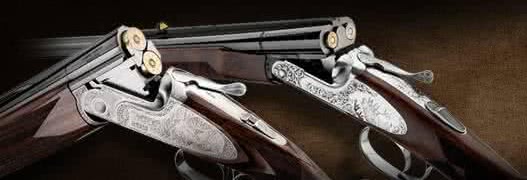



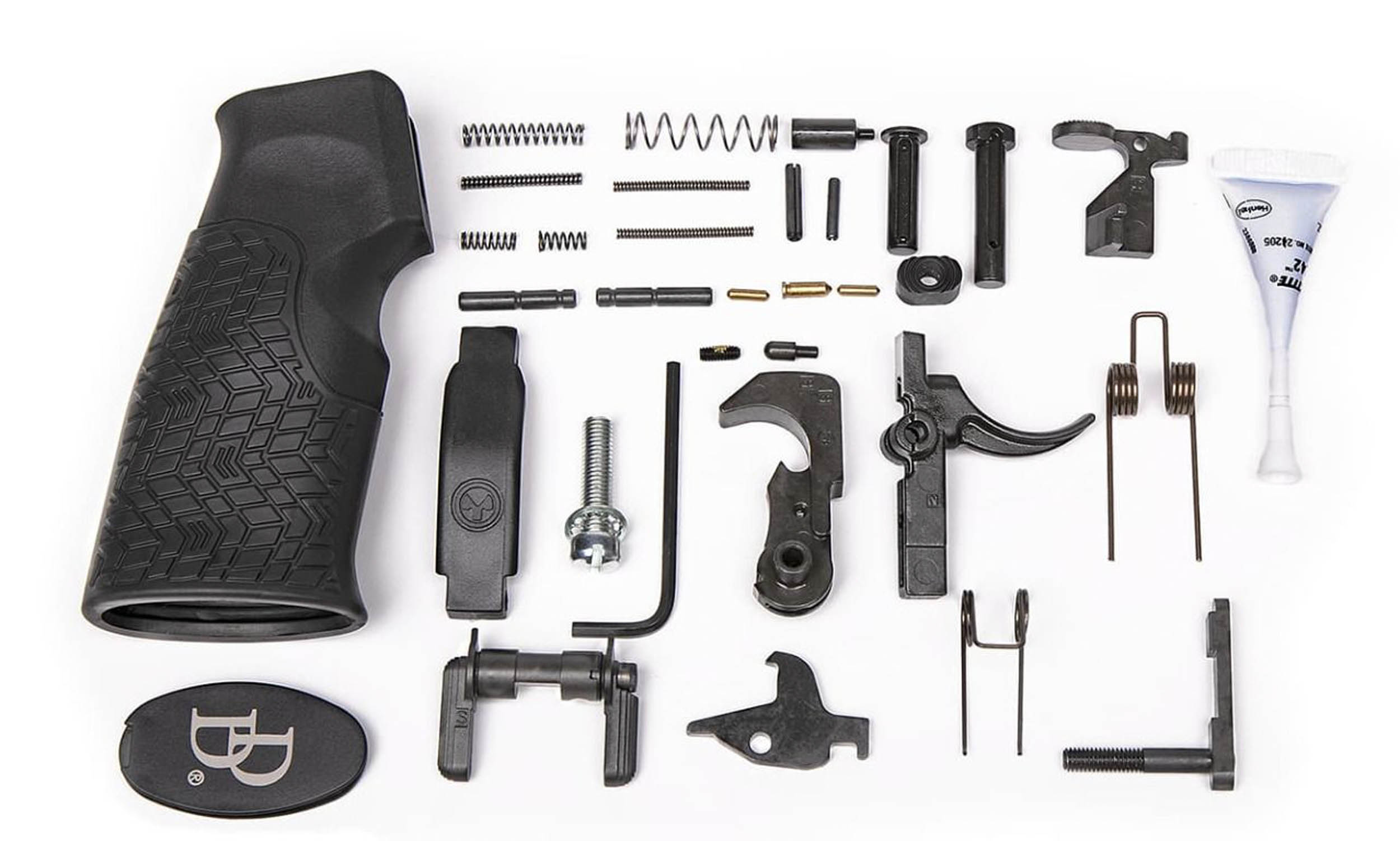
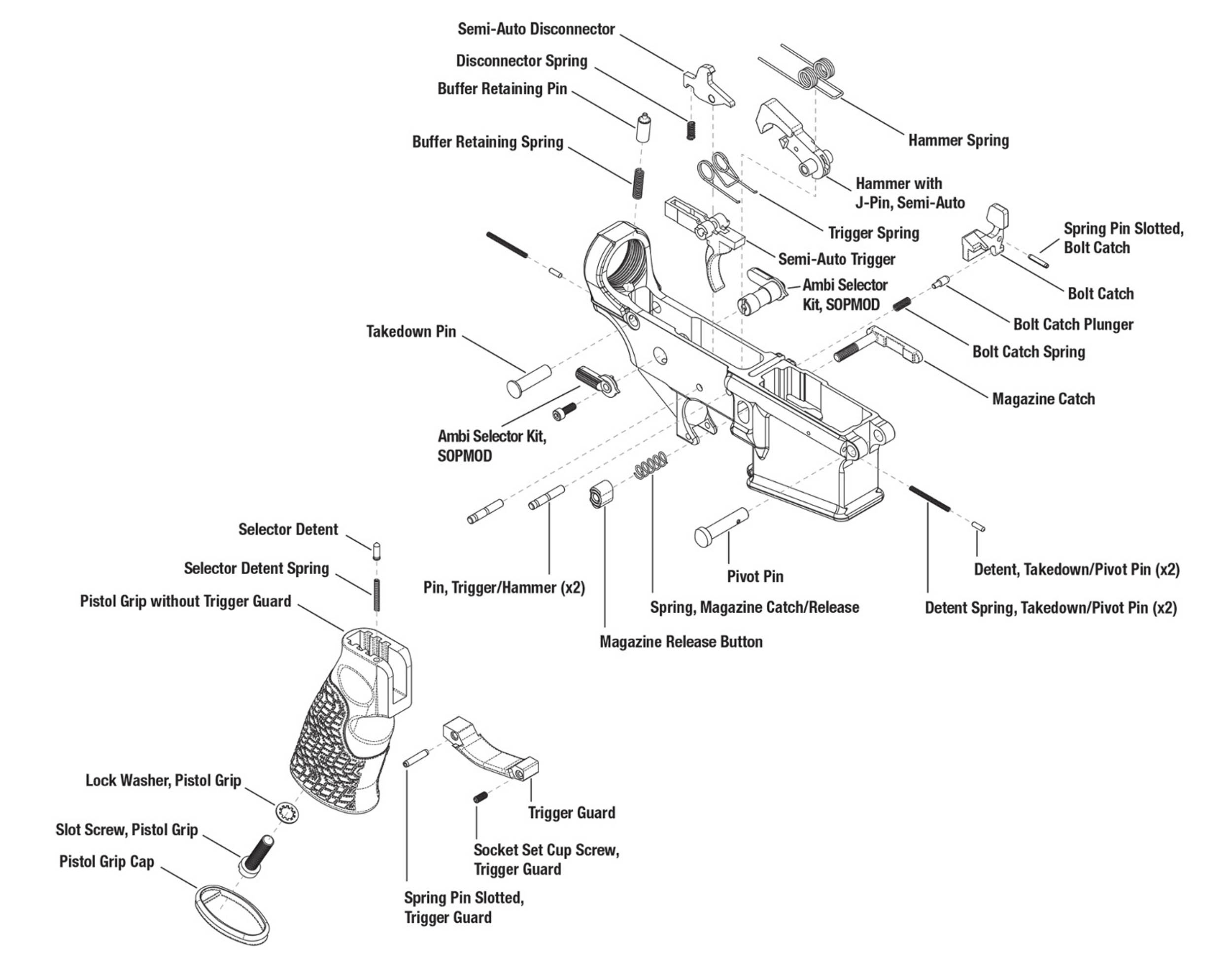
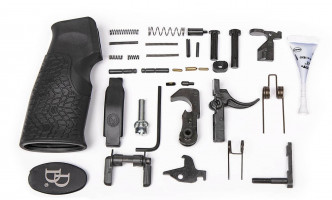
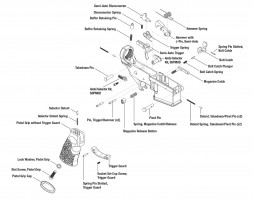
 Daniel Defense
Daniel Defense 